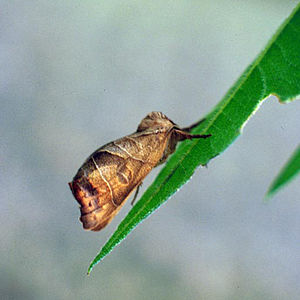Rust-brown grouse
| Rust-brown grouse | ||||||||||||
|---|---|---|---|---|---|---|---|---|---|---|---|---|

Russet moth ( Clostera anastomosis ) |
||||||||||||
| Systematics | ||||||||||||
|
||||||||||||
| Scientific name | ||||||||||||
| Clostera anastomosis | ||||||||||||
| ( Linnaeus , 1758) |
The rust-brown grouse ( Clostera anastomosis ), also known as the red- brown grouse , laurel willow moth or rust-brown drake tail , is a butterfly ( moth ) from the tooth moth family (Notodontidae).
features
butterfly
The average wingspan of the moths is 30 to 38 millimeters. The basic color of the forewings varies from red-brown to gray-brown. They are provided with three thin, mostly indistinct, light transverse lines. The dark brown middle field with the apical spot, which is cut through by the discoidal transverse vein, stands out more clearly . In the fringe area there is a wavy line made up of mostly elongated black-brown spots. The hind wings are gray-brown without drawing, in the females somewhat lighter. The thorax has a head of hair on its back. The tip of the abdomen is provided with an anal bush. In males it usually consists of two long tufts. The legs are densely hairy. The antennae of the males are long, those of the females shorter and finer feathered. The proboscis is stunted.
egg
The egg is hemispherical, initially white and later on a reddish color.
Caterpillar
Adult caterpillars are brownish in color, darker on the back. They are hairy yellow-brown and have two rows of white spots on their backs. There are orange-yellow stripes next to it. On the fourth and eleventh segments, bushy blackish humps stand out. The spiracles are black.
Doll
The doll has a black-brown sheen. Two rows of red and yellow dots and two equally colored, interrupted stripes can be seen on the back. The Kremaster is provided with a long tip and several short hairs. Pupation takes place in a thin gray-white cocoon .
Similar species
The small grouse ( Clostera pigra ) is smaller (wingspan 22 to 28 millimeters) and differs primarily through a more or less pronounced purple over-dusting of the front wings.
distribution and habitat
The rust-brown moth is widespread in Europe and occurs eastwards to China , Japan and Korea . The species prefers to colonize sparse aspen forests as well as floodplain and swamp forests.
Way of life
The species forms one generation a year in Northern Europe, the moths of which fly in May and June, in Central Europe they are found in two generations in April and May as well as in July and August. If specimens are found in southern regions in October, they should belong to a third generation. During the day, the moths sit in a resting position with wings folded like a roof over their abdomen, often on leaves, stems or twigs. At night they visit artificial light sources . The eggs are laid in several mirrors one on top of the other. Young caterpillars initially live gregariously, older caterpillars live individually. They feed on the leaves of various poplar ( Populus ) and willow species ( Salix ). The young caterpillars of the last generation hibernate together between leaves that are spun together.
Danger
The rust-brown grouse occurs in different frequencies in the German federal states and is included on the red list of endangered species on the warning list. In Baden-Württemberg , however, it is not considered endangered.
supporting documents
Individual evidence
- ↑ Walter Forster, Theodor A. Wohlfahrt: The butterflies of Central Europe. Volume 3: Weirdos and Swarmers. (Bombyces and Sphinges). Franckh'sche Verlagshandlung, Stuttgart 1960, DNB 456642196
- ↑ Josef J. de Freina: The Bombyces and Sphinges of the West Palaearctic. Volume 1. Noctuoidea, Sphingoidea, Geometoidea, Bombycoidea. EFW Edition Research & Science Verlag GmbH, Munich 1987, ISBN 3-926285-00-1
- ^ Hans-Josef Weidemann, Jochen Köhler: Moths, Spinners and Swarmers . Naturbuch-Verlag, Augsburg 1996, ISBN 3-89440-128-1
- ↑ Günter Ebert (Ed.): The Butterflies of Baden-Württemberg Volume 4, Moths II (Bombycidae, Endromidae, Lasiocampidae, Lemoniidae, Saturniidae, Sphingidae, Drepanidae, Notodontidae, Dilobidae, Lymantriidae, Ctenuchidae, Nolidae). Ulmer Verlag, Stuttgart 1994, ISBN 3-8001-3474-8
- ↑ Federal Agency for Nature Conservation (Ed.): Red List of Endangered Animals in Germany . Landwirtschaftsverlag, Münster 1998, ISBN 3-89624-110-9 .
literature
- Günter Ebert (Ed.): The Butterflies of Baden-Württemberg Volume 4, Moths II (Bombycidae, Endromidae, Lasiocampidae, Lemoniidae, Saturniidae, Sphingidae, Drepanidae, Notodontidae, Dilobidae, Lymantriidae, Ctenuchidae, Nolidae). Ulmer Verlag, Stuttgart 1994, ISBN 3-8001-3474-8
- Josef J. de Freina: The Bombyces and Sphinges of the West Palaearctic. Volume 1. Noctuoidea, Sphingoidea, Geometoidea, Bombycoidea. EFW Edition Research & Science Verlag GmbH, Munich 1987, ISBN 3-926285-00-1
- Walter Forster , Theodor A. Wohlfahrt : The butterflies of Central Europe. Volume 3: Weirdos and Swarmers. (Bombyces and Sphinges). Franckh'sche Verlagshandlung, Stuttgart 1960, DNB 456642196 .
- Manfred Koch : We determine butterflies. Volume 2: Bears, Spinners, Swarmers and Drills in Germany. 2nd, expanded edition. Neumann, Radebeul / Berlin 1964, DNB 452481929 .
- Arno Bergmann: The large butterflies of Central Germany. Volume 3: Weirdos and Swarmers. Distribution, forms and communities. Urania-Verlag, Jena 1953, DNB 450378365 .
Web links
- Lepiforum eV - taxonomy and photos
- www.funet.fi - dissemination
- www.schmetterlinge-deutschlands.de - endangerment
- Clostera anastomosis in Fauna Europaea. Retrieved June 8, 2013


